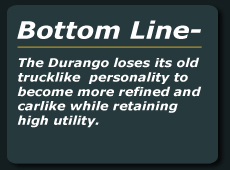2011 Dodge Durango
Redesigned
2011 Dodge Durango looks like a winner.
Prices--$29,195-$43,945
Except for its name, there’s virtually no resemblance between
the old truck-based Dodge Durango SUV and the redesigned 2011 Durango.
The new four-door Durango is handsome and fairly aerodynamic. It has
Dodge’s “crosshair grille” and looks a
little like the muscular, discontinued Dodge Magnum wagon.
There are four trim levels: Express, Crew (also offered with
a CrewLux lifestyle package), sporty R/T and Citadel. They come with
rear- or all-wheel-drive and have three rows of seats.
List prices range from $29,195 to $43,945, without an $850 shipping
charge. Add $2,000 for all-wheel drive.
To emphasize the Durango’s upscale nature, Dodge says there
are no “base” models.
Engines are Chrysler’s smooth new 3.6-liter, 290-horsepower
Pentastar V-6 with double overhead camshafts and a carryover 5.7-liter
Hemi V-8 with 360 horsepower. The V-6 has 260 pound-feet of
torque and provides lively performance. It should satisfy most Durango
buyers.
Those who want stronger acceleration and tow heavier objects should opt
for the Hemi, which produces a whopping 390 pound-feet of torque. It
switches seamlessly to fuel-saving four-cylinder mode when V-8 power
isn’t needed.
But fuel economy isn’t a strong point with either engine. The
V-6 with rear-drive produces 16 mpg in the city and 23 on highways or
16 and 22 with all-wheel drive. Figures with the V-8 are 14 and 20 with
rear-drive and 13 and 20 with all-wheel drive.
What’s the driving range (at least on paper)? Well, the
Durango’s fuel tank has a 24.6-gallon capacity.
Both engines can run on 87-octane gasoline, although Dodge notes that
the Hemi does best with 89-octane fuel
Watch option prices because they can raise prices a lot. My rear-drive
Crewlux model, which listed for $33,195, had a bottom line price of
$41,485—thanks to a $5,000 option package.
However, that package contained everything from 20-inch wheels (versus
the standard 18-inchers) and heated first- and second-row
leather-covered seats to a navigation system, power sunroof, adaptive
speed control and a front-collision warning system.
There are a fair number of stand-alone options, but all Durangos have a
good amount of comfort, convenience and safety
equipment—including electronic stability control. Even rear
air conditioning has headliner vents and rear-seat controls.
A rear back-up camera is optional for the Express and R/T, but standard
for the Crew and Citadel.
The Durango uses a rather old-fashioned five-speed automatic
transmission. It shifts very crisply, but a new eight-speed automatic
is reportedly on the way.
The interior—long a weak point—is improved so much
that older Durango owners may not believe their eyes when they see it.
The old rough cockpit has been replaced by a quiet, precisely
assembled interior with higher-quality soft-touch materials and
attractive stitching. The new seats are comfortable, gauges can be
easily read and controls work precisely. There’s even a soft
third-row armrest.
The Durango calls for a high step-in (and step-out), but the third-row
seat can be reached fairly easily and is generally roomy. However,
it’s only suited for two because it has a hard center area.
The old Durango was dropped in 2009, when the market for truck-based
SUVs had fallen apart. The old model had a truckish body on
frame design. The new Durango has more rigid carlike unibody
construction and rides on an extended version of the refined new Jeep
Grand Cherokee’s platform. It could be called a crossover,
but is considerably larger than some vehicles that carry that
classification.
The Durango has a comfortable ride with that platform, an
all-independent suspension and a long 119.8-inch -inch
wheelbase Some models have perfect 50-50 weight distribution,
while others are close to it.
While larger and heavier than the old Durango, the new model
“drives” smaller than it is. There’s
responsive steering, a compliant ride and good handling, thanks partly
to aggressive shock and spring rates and large sway bars. The R/T has
the best handling, due partly to a lowered ride height.
Adding to the Durango’s carlike nature is its tight turning
circle (37.1 feet)—especially impressive
for such a fairly big guy. The anti-lock brakes feel strong and are
controlled by a pedal with a nice linear action. They have
brake-assist, brake traction-control and rough-road detection systems.
Cargo room can be enhanced by the 60/40 split-foldling second-row seat,
which folds and tumbles. The third-row seat has a 50/50 split and is
easily folded from the rear. Both second- and third-row seats fold to
provide a flat load floor.
Dodge definitely may have a winner with this one.














